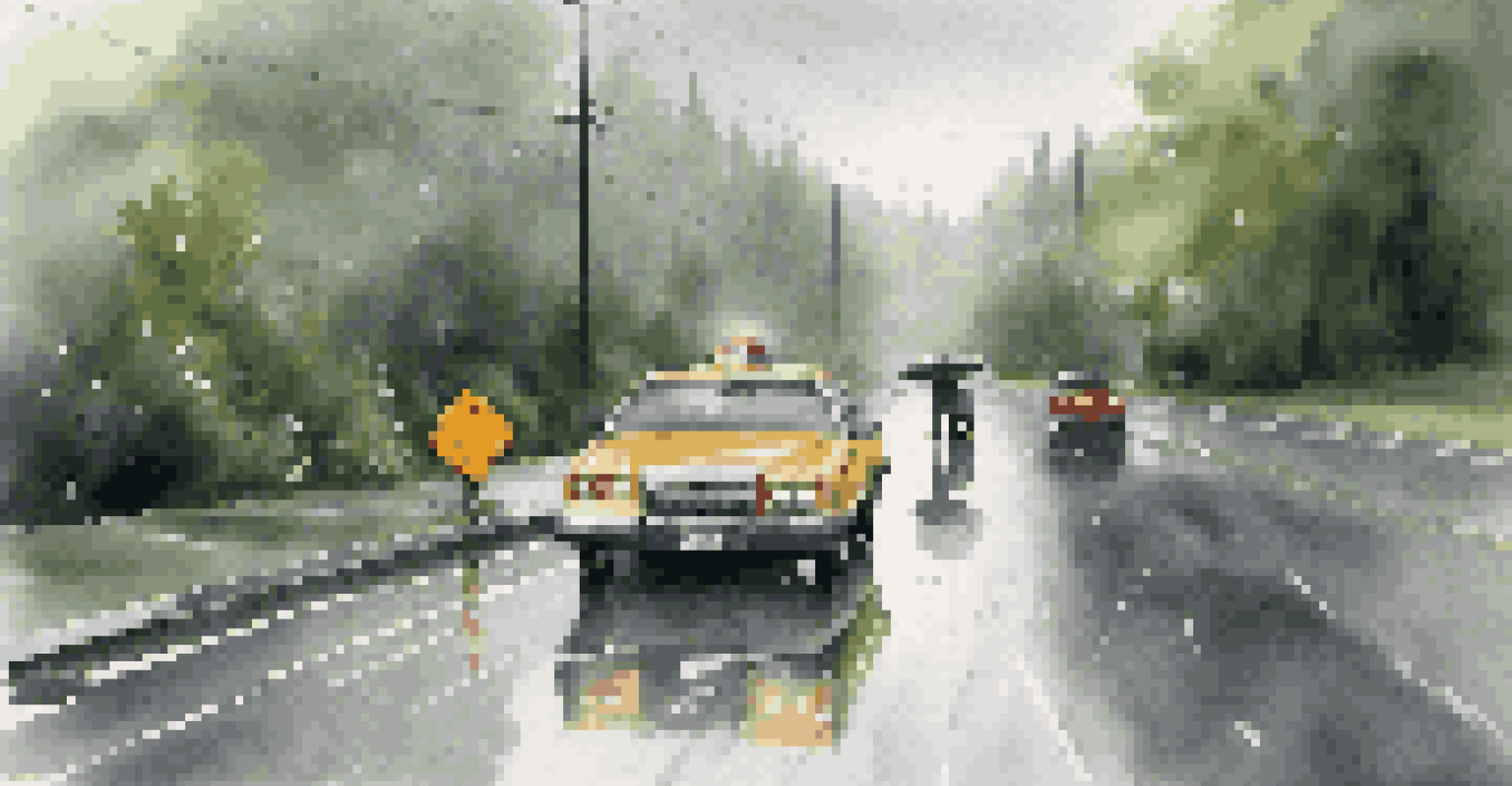Road Safety Tips When Traveling During Severe Weather

Understand Weather Conditions Before You Travel
Before hitting the road, take the time to check weather forecasts. Knowing what to expect can significantly affect your travel plans, especially in severe conditions like snow, rain, or storms. For example, a sudden snowstorm might prompt you to delay your trip or choose an alternative route.
The will to succeed is important, but what's more important is the will to prepare.
In addition to weather apps, consider following local news updates for real-time information. This helps you stay informed about changing conditions that might not be reflected in forecasts. Staying proactive can save you from potentially dangerous situations.
Finally, if severe weather is predicted, always have a backup plan. Whether it's identifying safe places to stop or alternative routes, being prepared can make all the difference in your travel experience.
Ensure Your Vehicle is Prepared for the Journey
A well-maintained vehicle can be your best ally in severe weather. Before you travel, check essential components like your tires, brakes, and windshield wipers. For instance, tires with good tread are crucial for maintaining traction on slippery roads.

Don’t forget to stock your car with emergency supplies, such as blankets, flashlights, and a first-aid kit. These items can be lifesavers if you find yourself stranded or facing an unexpected delay. Think of them as your safety net for the journey ahead.
Check Weather Before Traveling
Staying informed about weather conditions can help you adjust travel plans and avoid dangerous situations.
Lastly, ensure your fuel tank is full before you set out. In severe weather, you might encounter traffic delays or road closures, and having plenty of fuel allows you to navigate these challenges without added stress.
Adjust Your Driving Habits for Weather Conditions
Driving in severe weather requires a shift in how you approach the road. Slowing down is crucial; reduced speeds give you more time to react to unexpected situations. For example, in heavy rain, you might need to double your following distance to allow for longer stopping times.
In the midst of chaos, there is also opportunity.
Additionally, use your headlights wisely. In fog or heavy rain, visibility can drop significantly, so turning on your low beams can help you see better and be seen by others. Imagine yourself in a dense fog; those headlights can be the difference between seeing the road and not.
Lastly, avoid sudden maneuvers. Abrupt steering or hard braking on slippery surfaces can lead to skids or loss of control. Instead, practice smooth driving techniques to maintain stability and safety.
Stay Informed About Road Conditions
Keeping an eye on real-time road conditions is essential during severe weather travel. Use apps or websites that provide updates on road closures, accidents, and hazardous conditions. This information can help you make informed decisions about your route.
If possible, listen to local radio stations while driving. They often provide timely updates on traffic conditions and weather alerts, giving you insights that might not be available through other channels. Think of this as your travel companion, guiding you through the storm.
Prepare Your Vehicle for Safety
A well-maintained vehicle and emergency supplies are essential for navigating severe weather safely.
Remember, it’s better to be safe than sorry. If you encounter road conditions that seem unsafe, don’t hesitate to turn around or find an alternate route. Your safety should always come first.
Use Caution When Navigating Flooded Areas
Flooded roads can be deceptively dangerous. Even a small amount of water can sweep your vehicle away, so it’s important to avoid driving through flooded areas. If you can't see the road, it's best to turn back and find another way.
To gauge the depth of water, remember the old adage: 'Turn around, don’t drown.' This simple phrase encapsulates the importance of safety over convenience. It’s not worth risking your life for a shortcut.
If you find yourself in a potentially flooded area, stay alert for warning signs and barricades. These are put in place for your safety, and ignoring them can lead to dire consequences.
Maintain a Safe Distance from Other Vehicles
Keeping a safe distance from the vehicle ahead is especially important during severe weather. The recommended following distance typically doubles in poor weather conditions to give you ample time to react. For instance, if you usually maintain a two-second gap, aim for a four-second gap when it's raining or snowing.
This extra space allows you to brake more gently and reduces the chances of a collision. Picture yourself in a parade; the more space you have between floats, the better you can navigate unexpected stops.
Practice Safe Driving Habits
Adjusting your driving techniques, like maintaining safe distances and driving smoothly, is crucial in adverse weather.
Moreover, be mindful of larger vehicles like trucks and buses, which may have longer stopping distances. Keeping a safe distance from these vehicles can help you avoid potential accidents.
Have an Emergency Plan in Case of Breakdown
No one wants to think about a breakdown, especially in severe weather, but having an emergency plan is vital. Ensure you have a charged mobile phone and a car charger, so you can call for help if needed. Consider downloading roadside assistance apps as well, which can provide quick access to services.
Also, inform someone about your travel route and expected arrival time. This way, if you do run into trouble, someone will know where to look for you. It’s like having a buddy system, but for road trips.

Finally, remain calm if you do break down. Make sure to stay with your vehicle if it’s safe to do so, as it can provide shelter and makes it easier for rescuers to find you.
Stay Calm and Patient While Driving
Severe weather can test anyone’s patience on the road. It's important to remain calm and composed, even when you encounter delays or difficult driving conditions. Take a deep breath and remind yourself that safety is your top priority.
If traffic is heavy or movement is slow, use the time to listen to music or an audiobook to help you relax. This can transform a stressful situation into a more enjoyable experience, making the journey feel less daunting.
Finally, when you encounter aggressive drivers, don't engage. Instead, focus on your own driving and maintain a safe distance. Remember, staying calm not only benefits you but everyone sharing the road.